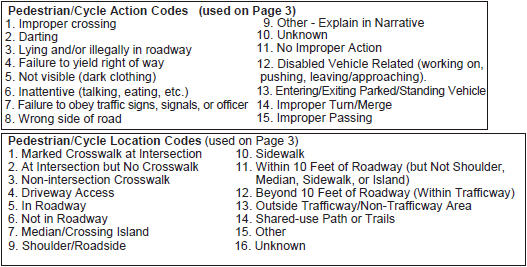INSTRUCTIONS FOR COMPLETING OVERLAY 1
ENVIRONMENTAL and ROADWAY CONDITIONS
A. Crash Type - Enter the crash type code in unshaded Box A. If there are no injuries or deaths involved, the crash is classified as property damage only. Enter the numeral “1". If a person is injured but no one is killed, the crash is classified as injury. Enter the numeral “2". If any person is killed in the crash, the crash is classified as a fatal crash. Enter the numeral “3". Classification can usually be done by ordinary observation at the time of the incident or from information submitted on the crash report.

NOTE: If it has been determined that there is an untimely death involved, the crash type is classified as “2. Injury”. (See Injury section later in this document.)
B. Vehicle 1 Collided With - Enter the code in B1 for what Vehicle #1 first collided with. For instance, if the vehicle collided with a deer in the roadway, then went off the road and hit a tree, only the first action indicating a deer collision (6) is entered in B1. The second action, hitting a tree (15), would be entered in B2.
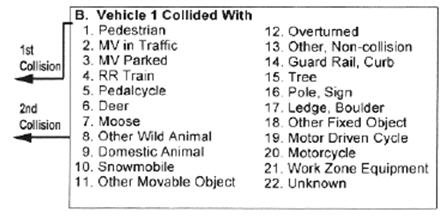
- Pedestrian: A pedestrian is a person who is not an occupant of a vehicle. Includes: person afoot, sitting, lying or working upon a land-way or place, or person in or operating a pedestrian conveyance. Excludes: person boarding or alighting from another conveyance, except a pedestrian conveyance.
- Pedalcycle: Is a vehicle in transport which is operated solely by pedals and propelled by human power. Includes any of the following devices: bicycle, tricycle, or unicycle. Trailers or sidecars attached to any of these devices are also included.
- Other movable objects include objects dropped from motor vehicle, fallen tree or stone, landslide or avalanche materials, or non-motorized devices not set in motion by railroad train or railroad vehicle.
- Other non-collision crash is any crash involving a motor vehicle in motion other than overturning and collision. Includes: accidental poisoning from carbon monoxide generated by a motor vehicle in transport; breakage of any part of the motor vehicle resulting in injury or in further property damage; explosion of any part of the motor vehicle; fire starting in the motor vehicle; fall, jump or being pushed from the motor vehicle; injury or damage from moving part of the motor vehicle; object falling from or in the motor vehicle; or injury or damage involving only the motor vehicle that is of a non-collision nature, such as a bridge giving way under the weight of a motor vehicle, striking holes or bumps on the surface of the traffic-way or driving into water without overturning or collision.
- Other fixed object refers to other fixed objects not specified in 14, 15, 16, 17 or 21. Includes: traffic signals, bridge abutment or similar objects placed for official purpose.
- Work zone equipment includes: construction machinery, construction materials or similar objects placed on or along the roadway for maintenance or construction of new roads, power lines, buildings, etc.
NOTE: There is no Section C.
D. Direction of Collision – This box is used for various types of collisions, including those involving turns or angle collisions. Enter the appropriate numeral for the collision.
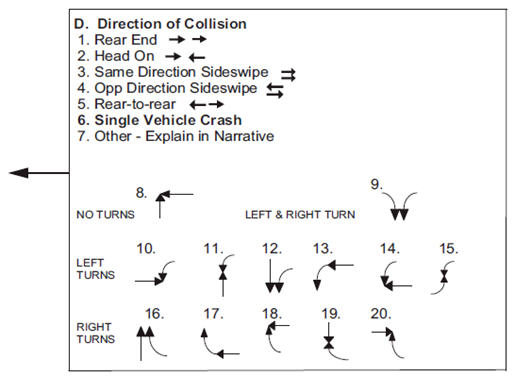
- Number 1 refers to a rear end crash where the front of one vehicle impacts the back of another vehicle.
- Number 2 refers to a head on crash where the front end of two vehicles impact. (A single vehicle crash cannot be termed “head on”.)
- Number 3 refers to a same direction sideswipe, a crash where two vehicles are traveling in the same direction and impact on the side.
- Number 4 refers to an opposite direction sideswipe, a crash where two vehicles are traveling in opposite directions and impact on the side.
- Number 5 refers to a rear-to-rear crash where the backs of two vehicles impact.
- Number 6 refers to a SINGLE vehicle crash, which is a crash involving only one vehicle.
- Other- this indicates the collision type is not one of the others. Use this option if the crash does not fall into any other category in this box.
- Number 8 refers to a “broadside” crash, where the front of one vehicle impacts the side of another vehicle.
- Number 9 refers to a simultaneous turn collision, where two vehicles turning from opposite direction make contact, or sideswipe.
Left Turns:
- Number 10 refers to an angle broadside, where one vehicle is moving/stopped straight and another is making a left turn. The impact is usually the front of one vehicle and the side of another.
- Number 11 refers to head on, where one vehicle is moving/stopped and the second turns left and hits first vehicle in the front.
- Number 12 refers to same direction sideswipe/angle collision, same direction. Vehicle one is moving/stopped essentially straight and vehicle two turns, making contact with vehicle one’s side. Passenger side makes contact with driver’s side.
- Number 13 refers to rear-end collision, where vehicle making left turn is hit in the rear by a second vehicle moving in the same direction.
- Number 14 refers to broadside, where a vehicle making a left turn is either hit by, or hits, a second vehicle traveling/stopped essentially straight ahead.
- Number 15 is a head on/angle collision, where two vehicles are making left turns that result in a head on collision or an angle collision.
Right Turns:
- Number 16 refers to same direction sideswipe/angle collision, same direction. Vehicle one is moving/stopped, essentially straight, and vehicle two turns right, making contact with vehicle one’s side. Passenger side makes contact with driver’s side. For example, a vehicle coming into Interstate via the on-ramp collides with a mainline vehicle moving through the interchange.
- Number 17 is a rear-end collision. A vehicle making a right turn is hit in the rear by a second vehicle moving in the same direction.
- Number 18 refers to a broadside collision, where a vehicle making a right turn is either hit by, or hits, a second vehicle traveling essentially straight ahead.
- Number 19 is a head-on, where one vehicle is moving/stopped and a second vehicle turns right and hits first vehicle in front.
- Number 20 is an angle broadside, where one vehicle is moving straight and another is making a right turn. The impact is usually the front of one vehicle and the side of another.
E. Traffic Control - Identify the type of traffic control which was present at the scene of the crash. Enter the appropriate code in Box E. Select the single type that was in control at the time. For example, an officer may direct traffic through a stop sign without having to stop traffic.
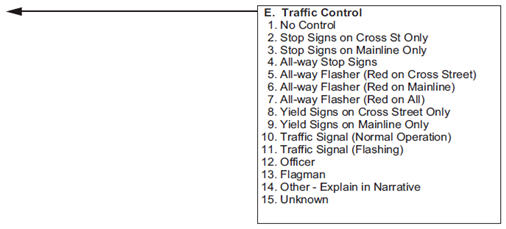
F. Weather Conditions - Enter the code that best describes the weather condition at the time of the crash. If more than one code applies, enter the code which you believe influenced the crash the most.
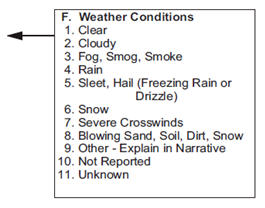
- Clear - Free from clouds, fog, smoke, and sky was more sunny than cloudy.
- Cloudy - Overcast with clouds. (Cloud - a visible mass of particles of water or ice in the form of fog, mist, or haze suspended usually at a considerable height in the air.)
- Fog, smog, smoke -
- Fog - a vapor condensed to fine particles of water suspended in the lower atmosphere that differs from cloud only in being near the ground.
- Smog - a fog made heavier and darker by smoke and chemical fumes.
- Smoke - the suspension of solid particles of combustion in the atmosphere.
- Rain - Water falling in drops condensed from vapor in the atmosphere.
- Sleet, Hail (freezing rain or drizzle) -
- Sleet - Frozen or partly frozen rain.
- Hail - Precipitation in the form of small balls or lumps usually consisting of concentric layers of clear ice and compact snow.
- Snow - White crystals of frozen water falling.
- Severe crosswinds - Winds at a high rate of speed blowing across the road.
- Blowing sand, soil, dirt, snow - Wind carrying sand, soil, dirt, or snow.
G. Light - Enter one code, which indicates the light condition at the time of the crash.

- Daylight - Those hours of day in which objects are clearly discernible without artificial light.
- Dawn - The first appearance of light in the morning.
- Dusk - The twilight hours of evening.
- Dark - lighted roadway
- Full darkness but the roadway is lighted by lights designed and installed to illuminate the roadway. This is not lighting from a store front, house lights, etc. Do not use this during periods of dawn, daylight and dusk even if streetlights are on.
- Full darkness but the roadway is lighted by lights designed and installed to illuminate the roadway. This is not lighting from a store front, house lights, etc. Do not use this during periods of dawn, daylight and dusk even if streetlights are on.
- Dark - roadway not lighted
- Full darkness and the roadway is not lighted by lights designed and installed to illuminate the roadway.
- Dark- unknown roadway lighting
- Full darkness but it is unknown whether roadway was lighted by lights designed and installed to illuminate the roadway.
H. Road Characteristics - Select the code that best describes the road characteristics at the scene of the crash.

I. Road Align (Alignment) - Fill in the code that best describes the curvature of the roadway.

J. Road Design - Enter the code that describes where the crash occurred. Note that the curvature of the road is not considered for this item.
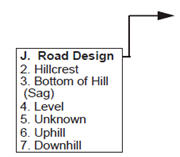
K. Road Type - This entry identifies the road type on which the crash took place. Select the code that best describes the roadway surface materials. If “other” is selected, describe in the narrative or a notation.
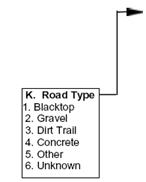
L. Surface Condition - Select the one code that describes the condition of the roadway’s surface at the time of the crash.

M. Contributing Road Conditions - Use this field to describe any road conditions that may have contributed to the crash.
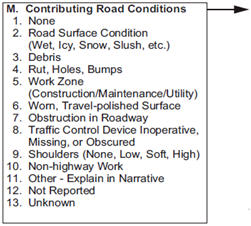
N. Police Photo/Video Recording Taken – Enter 1 for “yes” or 2 for “no” as to whether or not a police photo was taken or a video recording was made of the crash scene.
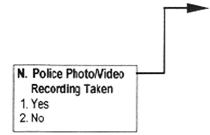
The remaining two boxes on overlay 1 are to be used for input into the “Operators, Occupants, Pedestrians, Cyclists” section on page 3.
